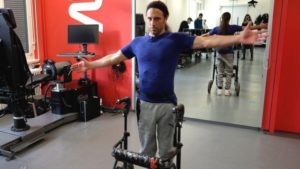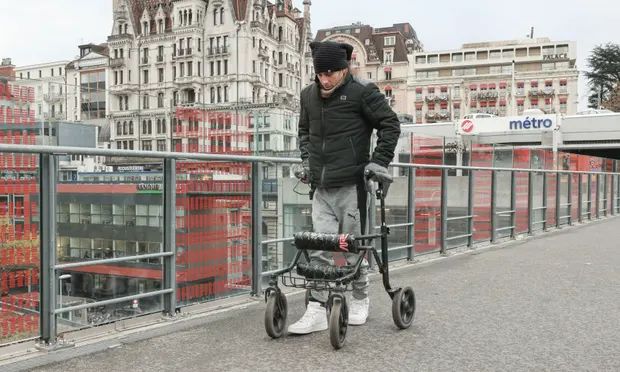A paralyzed man has managed to walk again, thanks to an experimental implant developed by a team of Swiss researchers.
It is the first time that someone who has suffered a complete severing of the spinal cord has walked freely again.
The same technology -used in 9 people- allowed to improve the health of another paralyzed patient to the point of allowing him to become a father.
The research that made this possible was published by the journal Nature Medicine.
Michel Roccati was paralyzed after a motorcycle accident five years ago. His spinal cord was severed completely and he lost all feeling in his legs. But now he can walk thanks to an electrical implant that was placed in his spinal cord.
Never before had someone who had suffered this type of injury been able to walk again.
The researchers stress that this is an experimental implant, not a cure for spinal cord injuries, and that the technology is still too complex to be used on a daily basis. However, they celebrate that it is a great step towards improving the quality of life of these patients.
I met Michel in the lab where the implant was created. He told me about that technology: “It’s a gift to me.”
“I can get up, walk where I want, I can go up the stairs. It’s almost a normal life,” she added.
But it hasn’t been technology alone that has fueled Michel’s recovery. This young Italian has an iron will. He told me that from the moment of the accident he was determined to progress as much as he could.

“I used to box, run and work out at the gym. After the accident, I was no longer able to do those things that I love, but I didn’t let it affect my spirits. I never stopped my rehab. I wanted to fix that problem,” she notes.
The speed with which Michel recovered surprised Jocelyne Bloch, the neurosurgeon at the Laboratory of Neurotherapies and Neuromodeling (LNTM) who placed the experimental implant and expertly attached electrodes to individual nerve fibers.
“I was extremely surprised. Michel is absolutely amazing. He should be able to use this technology to progress and get better and better,” the doctor told me.
The research has been supported by Dr Ram Hariharan, a consultant at Northern General Hospital in Sheffield, England, who is independent of the research team and is a spokesman for the Spinal Cord Injury Association.
“They have achieved something that had not been done before. I have never heard of any study where they put an experimental implant [in a patient with a complete spinal cord severing] and achieved muscle movement and improved balance enough to be able to get up and walk,” he said.
He added that more clinical trials are needed before he can be convinced that this is an effective treatment.
“We need more [patients] to show that it is safe first and also that it significantly improves their lives. Only then can it be carried forward”, she pointed out.
experimental treatment
Nerves in the spinal cord send signals from the brain to the legs. Some people become paralyzed when these nerves are damaged by injury.
In Michel’s case there is no signal because his spinal cord is completely severed, but the implant sends signals directly to his legs, allowing him to walk but only when the experimental implant is on.
So far nine people have received the implant and have regained the ability to walk. None of them use it to help them walk on a daily basis because at this point it is very complicated. Instead, they use it for walking practice, which exercises their muscles, improves their health, and often restores some movement.

David M’zee is another of the nine patients who have received this experimental treatment.
M’zee was one of the first patients to receive the implant. Like Michel, he can walk with the implant using a cane.
David’s health has improved so much that he has been able to father a daughter with his partner Janine, something that was not possible after the accident he suffered in 2010.
Their daughter, Zoe, is now one year old. When I was with them, she had a race with her dad using the baby walker and she really enjoyed winning. “It is fun. This is the first time I’ve walked with her like that. She with her walker and I with my cane, ”she added.
“Helps with hypertension. I suffered from it for a long time. At first I didn’t realize I had it. I got really tired from time to time. Once we discovered that the implant can increase blood pressure I said to myself ‘this is how life can be’”.
There is still a long way to go before the technology can be used routinely to help paralyzed people walk, according to Professor Grégoire Courtine, who led the team that developed the technology at École Polytechnique Fédérale de Lausanne ( Swiss).
“This is not a cure for spinal cord injury. But it is a fundamental step to improve people’s quality of life. We are going to empower people. We are going to give them the ability to stand up, to take a few steps. It’s not enough, but it’s a significant improvement,” she assured.
A cure would require regeneration of the spinal cord, possibly with stem cell therapies, which are still at a very early stage of research. Professor Courtine believes his implant technology could be used in conjunction with nerve regeneration treatments, once they are ready.















